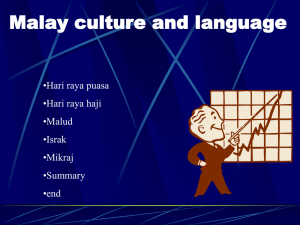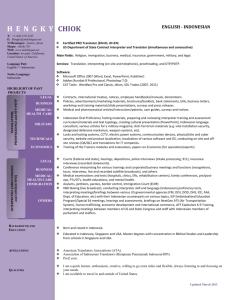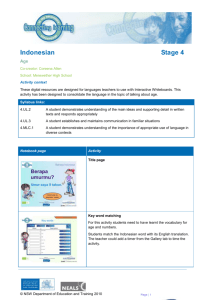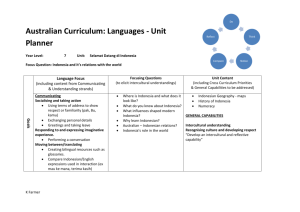Indonesian year 4 to 5 investigation
advertisement
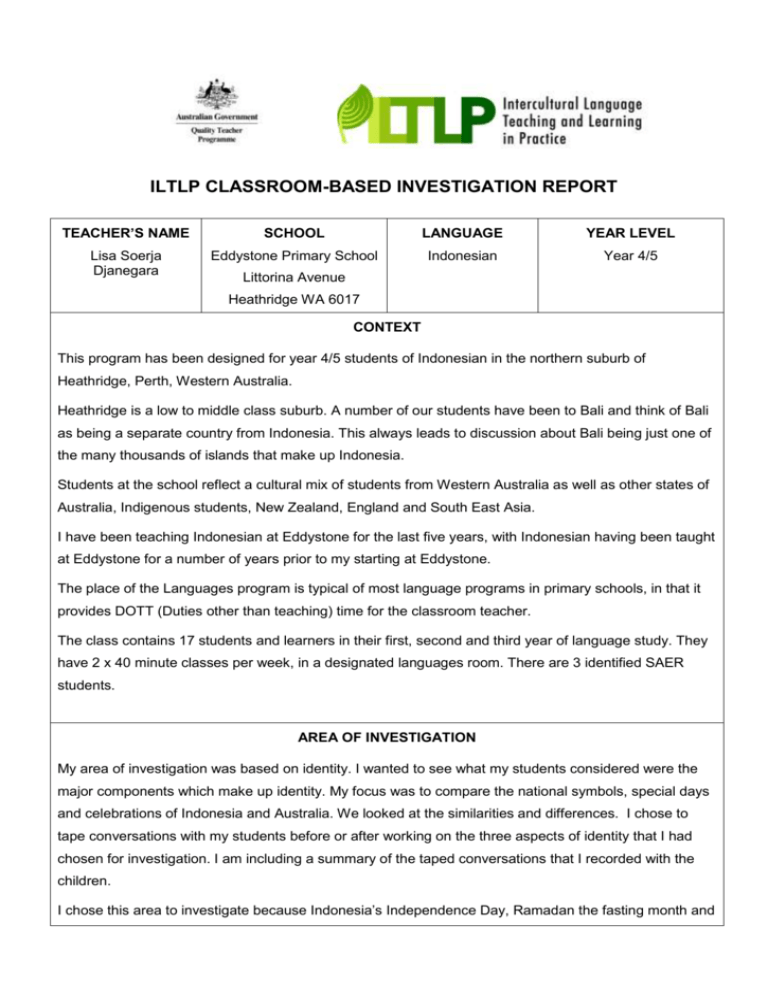
ILTLP CLASSROOM-BASED INVESTIGATION REPORT TEACHER’S NAME SCHOOL LANGUAGE YEAR LEVEL Lisa Soerja Djanegara Eddystone Primary School Indonesian Year 4/5 Littorina Avenue Heathridge WA 6017 CONTEXT This program has been designed for year 4/5 students of Indonesian in the northern suburb of Heathridge, Perth, Western Australia. Heathridge is a low to middle class suburb. A number of our students have been to Bali and think of Bali as being a separate country from Indonesia. This always leads to discussion about Bali being just one of the many thousands of islands that make up Indonesia. Students at the school reflect a cultural mix of students from Western Australia as well as other states of Australia, Indigenous students, New Zealand, England and South East Asia. I have been teaching Indonesian at Eddystone for the last five years, with Indonesian having been taught at Eddystone for a number of years prior to my starting at Eddystone. The place of the Languages program is typical of most language programs in primary schools, in that it provides DOTT (Duties other than teaching) time for the classroom teacher. The class contains 17 students and learners in their first, second and third year of language study. They have 2 x 40 minute classes per week, in a designated languages room. There are 3 identified SAER students. AREA OF INVESTIGATION My area of investigation was based on identity. I wanted to see what my students considered were the major components which make up identity. My focus was to compare the national symbols, special days and celebrations of Indonesia and Australia. We looked at the similarities and differences. I chose to tape conversations with my students before or after working on the three aspects of identity that I had chosen for investigation. I am including a summary of the taped conversations that I recorded with the children. I chose this area to investigate because Indonesia’s Independence Day, Ramadan the fasting month and the celebrations which follow Hari Raya Idul Fitri occurred during the period of my investigation. My students had never studied these areas before and I felt it was important to have an appreciation of these aspects of Indonesian culture and identity. These areas fitted in well with language we had studied this year, therefore allowing consolidation of previous language learning. This year we have studied about activities we enjoy engaging in while at school and different ways we can travel to school. This allowed us to use vocabulary relating to time eg, days, months and seasons. We looked at the types of activities engaged in at different times of the year. We have discussed likes and dislikes in the context of the students’ daily lives. I wanted to focus on the significance of hari besar (big days) and special days. In Indonesia not every hari besar is a hari libur (holiday). The way I plan didn’t really change, but my perspective changed. Instead of focusing on cultural issues I looked at how cultural issues can be viewed in an intercultural way. I tried to see how I could get my students to make meaning of the language and concepts I was teaching. One change that I made to my regular practice was to place a greater focus on intercultural language and learning within the context of the way I deliver my lessons. I tried to do this by getting students to observe and notice what they were doing and questioning them on the choices they made. This is the first time I have taped conversations with my students. CLASSROOM PRACTICE I started my investigation by informing the children that I had selected them to be a part of the ILTLP national project. I informed the children that I would be taping our conversations as they were an important part of the teaching/learning process, and this would allow me to reflect on the children’s comments. At the beginning of each stage of the investigation I discussed with the children what we were investigating. I asked questions to try to establish their prior learning on the subject of investigation. I used their prior learning to connect them to the new subject matter in our investigations. My focus on establishing connections with prior learning has always been something that I have done however during this investigation I used this approach to increase intercultural language learning. Our first area of study was the Australian and Indonesian Flags. We looked at the design features of each flag and what had influenced the choice of flags for both countries. Students read that both flags were influenced by their own history. Students discovered that both Australia and Indonesia adopted their flags. When I asked the students what adopting a flag meant they were perplexed. This led to conversations about the meaning of the word adopting. After some period of discussion the students came to understand that adopting meant to make it your own, to take ownership of the thing being adopted. I informed the students that the word for flag – bendera in Indonesian comes from the Portuguese language. Once again students were puzzled. I asked them how a Portuguese word like bendera became a word in the Indonesian language. They had no answer to this question so I explained a little about the history of the spice trade. The students were impressed with the significance and the meaning behind the symbolism in Indonesia’s national emblem. They were learning about Australia’s national emblem in class, so were able to see the importance of the symbolism involved. On learning how the number of feathers in the wing, tail and neck represent the date of Indonesia’s independence the boys were the first to tell me that that was ‘cool!’ We compared the two celebrations of Hari Natal (Christmas) and Hari Raya Idul Fitri by producing a list in Indonesian of the things that are associated with the two celebrations. Once this was completed they were displayed in the classroom and the students were asked to look at and compare what they had done. I interviewed the students after they had viewed each other’s work. DATA OR INFORMATION GATHERED I used an audio cassette player to tape the conversations the children and I had before or after our investigations. I have chosen not to identify the students by name in the transcript, as this is not important. When only one student responded to a question the word student is singular, and when a number of students have responded with the same answer the word students is pluralised. I also collected written work samples of the children’s work on celebrations. The children were keen to participate and share their knowledge. Sometimes there was a flood of responses to questions asked, while at other times one child would give a response and several children would say the same thing in a slightly different way. The following is a transcript of the conversations I recorded with the students. I have divided the transcript into the three areas of my investigation. Identity Teacher: What do you think of when we talk about identity? Students: What’s your first name, your fingerprints, your DNA? Where you’re from, where you live, your language. Your language. Your passport. Where you are born and who is your family. Your whole name. Your religion. Where your middle name came from. Where your parents come from. Teacher: We were looking at a personal level but what would it be like at a country or national level? What sort of things will tell us about identity at a national level? Student: Is your country famous. Teacher: What sort of things will tell us about our national identity? Students: What country you are from. How are we related to other countries? Our flag. Our states. Our favourite hobby – national pastimes. Our national anthem. Teacher: We are talking about national symbols. Today as part of looking at national identity we are going to look at Australia and Indonesia flags. What sort of things do you think they have in common? Students: Same colours. Australian flag has stars on it. Both have colours red and white. Teacher: Let’s look at National Symbols. Why are we looking at Australian symbols? What does it help us to understand? Students: So you can identify things to do with Australia. Teacher: Do you think that is important? Students: Yes/ No. Teacher: Some say yes some say no. Student: They know that their country is important to them and our country is important to us. Hari Besar: Special Days. Teacher: Looking at Hari Besar, what did you notice about Hari Besar in Australia and Indonesia? Students: There are lots of special days. Hari Besar means Day Big and in Australia that means Big Day Did you notice any similarities and differences between the types of Hari Besar? Yes, sometimes the dates are exactly the same. Sometimes the dates aren’t exactly the same. Some are the same. Sometimes we celebrate at the same time on the same date. Sometimes we celebrate on the same date and sometimes we don’t. Teacher: In Indonesia they have ‘Hari Pahlawan.’ We were talking about Hari Pahlawan being hero’s day. Of all the days which one is it most similar to? Students: Anzac day. Teacher: We looked at Hari Kemerdekaan di Indonesia and we talked about that being Independence day. Which day is that most similar to? Students: Australia Day. Celebrations: Christmas and Idul Fitri. Teacher: So what do we notice about our two countries? We’ve just looked at two days? What did you notice about the two celebrations? One was Hari Natal or Christmas and the other was Hari Raya Idul Fitri which is the celebration after the fasting month. Students: They celebrate the same kind of stuff. You sort of do the same stuff. You get presents. You’d have to be one of them to understand it. Teacher: What place did the family play? Was family important in these celebrations? Students: Yes, because you’re basically remembering like you’re basically forgiving like things that people have done to you that might have upset you. And that sort of brings you closer to your family and friends. And you all feel happy Teacher: How would you feel if you were invited to celebrate, say you made a new friend and that person asked you to be a part of their celebration for Hari Raya? Students: I’d feel honoured. Because you don’t know how they’d do it (celebrate) because people do it in different ways. Some people might have a big party some people might have a roast and some people do stuff. Teacher: You’d be honoured. That’s a very humble thing to say What would you want to learn? What would you want to find out? Students: I’d want to find out how they celebrate in their way because some people don’t do it the way other people do it. Like England and America they celebrate theirs (Christmas) in winter and we celebrate ours in spring or summer. Yeah, I’m from the UK they celebrate it in winter. They get to build snowmen and stuff like that. But here because it is in the summer and it’s really hot, it’s cool because we get to celebrate it at the beach. Teacher: What did you notice about the two celebrations? Students: They all have different ways of celebrating and they do different things at different times Teacher: How would you feel if you were invited? Students: I’d feel really cool and I would invite them over to make up for what they did for me. Excited. I’d be very excited because I’d be the only one in my family who did it and like them (the other children) I could go home and tell everyone what I did and I’d feel really special. I’d feel very excited that I’m trying something different and new. Something that I’ve never done before I feel excited and happy. Teacher: What would you want to know? Students: What games do you play? What do you do? Is there anything that I would not be allowed to eat? Teacher: What do you think you would ask? Student: I’d ask ‘What’s this? What’s that? What do you do there?’ I’d go back and tell everyone about it. I’d tell my friends about it. I’d share the news with everyone. I’d tell it for news. FINDINGS The children were enthusiastic and able to contribute well when they had either experience, knowledge of or understood what was being asked of them. The children’s view of identity was based on tangible elements of identity like one’s name, nationality, where someone came from and their language. Their view of celebrations was personal and based on their experiences. For most of my students Christmas was about presents, food, the beach and parties. Only a few students talked about going to church at Christmas, however for these students this was the only time they went to church. The students had no knowledge of Idul Fitri. When we discussed Idul Fitri and I explained that at this time people ask forgiveness of each other for anything they may or may not have said or done in the past year they found this to be strange. There was no equivalent in Australian culture that they could relate this action with. They could only relate to asking for forgiveness if they had directly hurt or upset someone. When I said to the students that Idul Fitri could be compared with Christmas because people wore new clothes, special food was prepared, families came together and children were given money by their parents, they could see similarities. The students were curious to know more about Idul Fitri. This was evident when I asked them about how they would feel and what would they want to know if they were invited by a Muslim friend to attend an Idul Fitri celebration. INTERPRETING THE INFORMATION I enjoyed the way the children responded to the investigation. The students were curious about the new things they were learning. While we managed to discuss and try to gain an insight into the way Idul Fitri is celebrated, it did not hold much significance for the students because it was not something that they have experienced. I would have liked to be able to have made it real for them but that was not possible. The investigation went well with only one student surprising me by his thoughtful response saying that he would be ‘honoured’ to be invited to an Idul Fitri celebration. I wonder if my investigation can be said to be intercultural as this is a concept that I am still trying to understand. Sometimes I feel that I understand how to teach in an intercultural manner and at other times I wonder if I am approaching this with the right mind set. I think my understanding of intercultural language teaching and learning is something that still needs exploring and developing. One investigation is not sufficient to say that the concept of intercultural language teaching and learning has been conquered. MATERIALS AND EXEMPLARS Indonesian Year: 4/5 ( Levels 1, 2) Duration: 10 weeks Topic: “Identity, Special Days and Celebrations.” OUTCOME 1: OUTCOME 2: OUTCOME 3: Listening and Responding and Speaking Viewing, Reading and Responding Writing Level 1: The student listens to Indonesian, demonstrates understanding through nonverbal response, repetition, action or response in English. Level 1: The student views and reads simple texts with extensive contextual and teacher support and identifies specific items of information. Level 2: The student listens to Indonesian and gives simple, formulaic responses in the Indonesian. Level 2: The student views and reads simple texts with contextual and teacher support and locates and identifies key words and specific information. Level 1: The student writes or reproduces letters, characters or words from models in the print environment. WHAT NEEDS TO BE TAUGHT/ LEARNT CULTURAL UNDERSTANDINGS: SYSTEM OF THE INDONESIAN LANGUAGE: Influence of Portuguese words like Bendera. Adopting flags. Looking at what our national symbols say about us as a nation. The significance of the colours used in national symbols. Colours and numbers. Hari besar/ hari libur Not every hari besar is a hari libur. Sharing similar significant days. Greeting others on special occasions. The significance of forgiving and asking for forgiveness. Days of the week and months in Indonesian. Use of selamat Use of question words berapa, apa Use of ini and itu. Noun-adjective word order eg, hari besar LANGUAGE LEARNING STRATEGIES: Modelling good pronunciation and intonation. Memorising simple formulaic expressions. Relating new information to background knowledge. Cooperating with classmates, taking turns. Working independently. Pronouns saya, dia, -nya. Use of some me- and ber- verbs Use of pada, suka and sekali Use of mohon, maaf, lahir dan batin LEARNING EXPERIENCES: RESOURCES: Daily greeting and responding to routine ongoing classroom language. Books: Find out and colour the Indonesian and Australian flags, when they were adopted and what is the significance of the colours and symbols used. Read and answer questions related to the Australian and Indonesian flags. Indonesian Kaleidoscope. Key into Indonesia. Own worksheet on Bendera Indonesia and Australia. Australian and Indonesian flags. Colour, cut out and put together the pieces of the Indonesian Coat Idul Fitri greeting cards. of arms. Find out the significance of each aspect of the Coat of Arms. Pancasila and its meaning and significance. Cassette player. Creating an Indonesian/English word dictionary about Hari Natal and Hari Raya Idul Fitri. Making an Idul Fitri greeting card. Forgiving and asking forgiveness in Indonesian. ASSESSMENT: Listening and Responding, and Speaking. Presentation of posters. Greeting others on special occasions. The students enjoyed making Idul Fitri cards and I loved what they produced. I choose not to show them Idul Fitri Cards until they had finished as I wanted to see how they expressed their understanding through their designs. I felt they captured the essence of the celebration though their choice of style, colour and the symbols they used. The Indonesian/English word dictionary about Hari Natal and Hari Raya Idul Fitri was a very interesting activity. The students knew exactly what words and illustrations they needed for Hari Natal. When they started the Hari Raya Idul Fitri word bank they needed a lot of support, even though we had looked at pictures of Hari Raya Idul Fitri celebrations and discussed what we had observed. The yellow writing reads ‘Praying – berdoa.’ EVALUATION I think the investigation went well. The students were introduced to aspects of Indonesian identity that they had not thought of, or had knowledge about. They realised that the lives of Indonesians are similar to Australians as we both place importance on national symbols, special days, and the importance of the role of families in celebrating special traditional/religious events like Hari Natal and Hari Raya Idul Fitri. It was a valuable experience for me as I had not previously covered identity in relation to national symbols, special days and celebrations. In the past I had covered the topic of Hari Natal in the last few weeks of the school year. I had left looking the exploration of Hari Natal/Christmas to the classroom teacher. I think it was valuable for the students to reflect on their identity and then compare this with how Indonesians live their lives and value similar things and sometimes the same things as they do. I would further develop the investigation by trying to find suitable video and reading materials for the students. I think this would enhance their understanding of the subject matter and aid in intercultural understanding. I would like to do more reading about intercultural language learning and teaching. In particular how to teach intercultural language teaching and learning in a primary school. REFLECTION I enjoyed doing the investigation, but I found it challenging to do this within the context of teaching the target language. My students have very limited target language ability and can only truly express themselves in English. My investigation was conducted using both English and the target language. Recording the students was problematic as the cassette recorder I used was not very good and made listening back to what the students had said difficult. At times I felt that I had a sound understanding of intercultural language learning and at other times I felt like I was grappling with my understanding of intercultural language learning. I think that this process and the investigation have highlighted the importance of finding the deeper meanings and trying to get my students to discover those meanings by themselves. How we present what we do in the classroom to our students requires constant reviewing in order to remain fresh and relevant.
